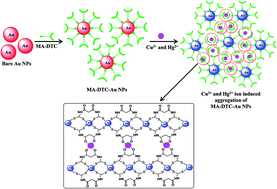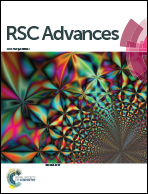Malonamide dithiocarbamate functionalized gold nanoparticles for colorimetric sensing of Cu2+ and Hg2+ ions†
Abstract
In this study, a colorimetric probe was developed based on malonamide dithiocarbamate functionalized gold nanoparticles (MA–DTC–Au NPs) for the simultaneous colorimetric detection of Cu2+ and Hg2+ ions. The MA–DTC–Au NPs quickly aggregated in the presence of Cu2+ and Hg2+ ions, resulting in a color change from red to blue and a red-shift in their surface plasmon resonance peak (SPR) from 525 to 780 nm and to 680 nm for Cu2+ and Hg2+ ions, respectively. On the basis of this, the concentration of Cu2+ and Hg2+ ions can be visualized with the naked eye and can be quantitatively determined by UV-visible spectroscopy. The absorption ratios A780 nm/A525 nm and A680 nm/A525 nm show linear relationships with Cu2+ and Hg2+ ion concentrations within concentration ranges from 0.01 to 5 and 0.01 to 10 μM. The detection limits are as low as 41 nM and 45 nM for Cu2+ and Hg2+ ions, respectively. The MA–DTC–Au NPs were used as a potential colorimetric probe for the rapid, selective and sensitive detection of Cu2+ and Hg2+ ions in environmental water samples (drinking, tap, canal and river water).


 Please wait while we load your content...
Please wait while we load your content...